- Home
- About
- Map
- Trips
- Bringing Boat West
- Migration West
- Solo Motorcycle Ride
- Final Family XC Trip
- Colorado Rockies
- Graduates' XC Trip
- Yosemite & Nevada
- Colorado & Utah
- Best of Utah
- Southern Loop
- Pacific Northwest
- Northern Loop
- Los Angeles to NYC
- East Coast Trips
- 1 Week in Quebec
- Southeast Coast
- NH Backpacking
- Martha's Vineyard
- Canadian Maritimes
- Ocracoke Island
- Edisto Island
- First Landing '02
- Hunting Island '02
- Stowe in Winter
- Hunting Island '01
- Lake Placid
- Chesapeake
- Provincetown
- Hunting Island '00
- Acadia in Winter
- Boston Suburbs
- Niagara Falls
- First Landing '99
- Cape Hatteras
- West Coast Trips
- Utah Off-Roading
- Maui
- Mojave 4WD Course
- Colorado River Rafting
- Bishop & Death Valley
- Kauai
- Yosemite Fall
- Utah Off-Road
- Lost Coast
- Yosemite Valley
- Arizona and New Mexico
- Pescadero & Capitola
- Bishop & Death Valley
- San Diego, Anza Borrego, Joshua Tree
- Carmel
- Death Valley in Fall
- Yosemite in the Fall
- Pacific Northwest
- Utah Off-Roading
- Southern CA Deserts
- Yosemite & Covid
- Lake Powell Covid
- Eastern Sierra & Covid
- Bishop & Death Valley
- Central & SE Oregon
- Mojave Road
- Eastern Sierra
- Trinity Alps
- Tuolumne Meadows
- Lake Powell Boating
- Eastern Sierra
- Yosemite Winter
- Hawaii
- 4WD Eastern Sierra
- 4WD Death Valley +
- Southern CA Deserts
- Christmas in Tahoe
- Yosemite & Pinnacles
- Totality
- Yosemite & Sierra
- Yosemite Christmas
- Yosemite, San Diego
- Yosemite & North CA
- Seattle to Sierra
- Southwest Deserts
- Yosemite & Sierra
- Pacific Northwest
- Yosemite & South CA
- Pacific Northwest
- Northern California
- Southern Alaska
- Vancouver Island
- International Trips
- Index
- Tips
- Books
- Photos/Videos
- Search
- Contact
Page
Sunday, July 1, 2018 - 9:00pm by Lolo879 miles and 17 hours from our last stop - 1 night stay
Travelogue
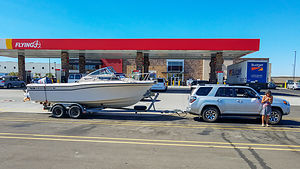 Towing the boatRather than bore anyone reading this blog (and myself writing it) about the pickup of the boat in Lake Mead and trailering it to Lake Powell, which took us 2 days, I am going to start my narrative with our arrival in Page, Arizona, on the shores of beautiful Lake Powell.
Towing the boatRather than bore anyone reading this blog (and myself writing it) about the pickup of the boat in Lake Mead and trailering it to Lake Powell, which took us 2 days, I am going to start my narrative with our arrival in Page, Arizona, on the shores of beautiful Lake Powell.
Rather than launching the boat in late afternoon on a Sunday (a very busy time for a boat launch) and searching for a canyon to camp in for the night, we had decided ahead of time to stay in a hotel in Page and launch early Monday morning. I somewhat randomly chose the Page Boy motel, a bit of a disappointment but since we are campers, we coped.
Before going to the hotel, we dropped the boat and trailer off at the Wahweap Resort and Marina for the night. Surprisingly the resort lets people do that for free.
Freed from the boat and before checking into our hotel, we decided to scout out the Horseshoe Bend Overlook, one of the area’s most popular and photographed sites. It was early afternoon, not the best time to photograph it, so we figured we would check it out now and then come back at sunset and then again for sunrise tomorrow morning when the lighting would be more dramatic.
The parking lot was a zoo, even though this was the worst time of the day to see it - extremely hot and bad lighting. Well, here we were too joining the mass of humanity along the ¾-mile trail over a sandy ridge to the edge of a cliff overlooking a sharp, dramatic bend in the Colorado River. There were no guardrails and the drop to the river was 1,000 feet, making it a bit intimidating to get close enough to view the entire river rounding the rocky peninsula.
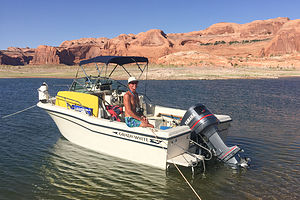 Herb and his boatIf it was this crowded now, what would tonight be like?
Herb and his boatIf it was this crowded now, what would tonight be like?
We checked into our motel, relaxed a bit, had a pizza at nearby Strombolli’s, and then headed back to the Horseshoe Bend Overlook.
We never did get to the Overlook that evening, for reasons I still have trouble reliving. Let me first give away the ending and say that nothing bad happened - just a very, very bad false alarm.
As we were jockeying for a parking space, I noticed a had a missed call from a Texas phone number - just an annoying sales call I thought. Then my phone rang again - same number. This time I picked it up. The man on the other end identified himself as being part of the International Emergency Response Center, and that they had received an SOS call from my son’s Garmin Inreach Explorer, a satellite communication device which he owns because he is often climbing, mountaineering, skiing, etc. in rather remote places. He said it was strange that they did not receive their GPS coordinates with the SOS, which might mean the device was deep inside a backpack, which might indicate a false alarm. We told him that all we knew is that he was rock climbing somewhere in the Eastern Sierra.
I’m not going to go into the details of how we spent the next three hours before learning that they were fine. Suffice it to say, it was the longest three hours of my life. Jacob (our contact at the IERC), however, was great, and very comforting. He called us about 20 minutes later to let us know that they had received their coordinates. They were located along the ridge of Mt. Conness, a remote mountain outside the eastern boundary of Yosemite. A ground search crew was being dispatched to the area, as it was too dark to send out a helicopter.
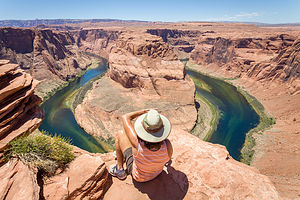 Lolo overlooking Horseshoe BendWhile we were on the phone with him, he told us that they had moved 120 feet, and that this movement was a good sign. Over the next couple of hours, Jacob called us periodically to give us their coordinates, which allowed us to see that they were moving at a good pace down the ridge of Mt. Conness.
Lolo overlooking Horseshoe BendWhile we were on the phone with him, he told us that they had moved 120 feet, and that this movement was a good sign. Over the next couple of hours, Jacob called us periodically to give us their coordinates, which allowed us to see that they were moving at a good pace down the ridge of Mt. Conness.
Herb was extremely comforting and tried to convince me that the most likely explanation was a false alarm - a google search confirmed that the particular device he owned had been responsible for several false SOS’s in the past. Still, we just had to hear his voice.
Finally, at 10:00, we received word that they had met up with the rescuers (over a dozen of them) and they were fine. My son was quite surprised to be greeted by name by a search and rescue crew, as they had no idea that they had sent out an SOS. The rescue team asked to see his satellite communicator, and sure enough, the Power was Off. No signal should have been sent. I’m sure he was relieved that they knew it was not his fault.
One of the responders let him use his satellite phone to call us - there is absolutely no cell phone coverage in that area so it was the only way he could talk to us. I can’t tell you how good it was to hear his voice.
We were emotionally and physically drained. No early wake-up for sunrise at Horseshoe Bend for us. I think we really needed to sleep in.
It definitely put things in perspective. There would be no complaining and sweating the little stuff for us this trip.
Home
Thursday, May 31, 2018 - 5:45pm by Lolo187 miles and 4 hours from our last stop - 1 night stay
Travelogue
Home Sweet Home!
South Lake Tahoe
Wednesday, May 30, 2018 - 5:15pm by Lolo104 miles and 2.5 hours from our last stop - 1 night stay
Travelogue
 Fannette Island in Lake TahoeRather than taking the shortest route home from the Eastern Sierra through Yosemite, we usually take the more gentler (in terms of mountain passes) route up 395 to Gardnerville, Nevada and then down through South Lake Tahoe.
Fannette Island in Lake TahoeRather than taking the shortest route home from the Eastern Sierra through Yosemite, we usually take the more gentler (in terms of mountain passes) route up 395 to Gardnerville, Nevada and then down through South Lake Tahoe.
Since we were in no particular rush to get home, we decided to squeeze another day into our mini-vacation and spend the night in South Lake Tahoe. We called the Camp Richardson campground to see if there was room for us, but they told us that they were not open on weekdays for another week.
There was another campground right across the street from the lake a little further east that we had always been curious about. After a little bit of research, I found out that it is called Campground by the Lake and it is owned and operated by the City of South Lake Tahoe Recreation Services Department. I gave them a call and found out that they were indeed open and that they did have space for us that night.
 Upper Eagle FallsThe campground was quite nice and is part of a complex with other city recreational facilities, such as an indoor heated swimming pool, an ice arena, basketball courts, pickleball, etc. The day use cost to use these facilities is $6.
Upper Eagle FallsThe campground was quite nice and is part of a complex with other city recreational facilities, such as an indoor heated swimming pool, an ice arena, basketball courts, pickleball, etc. The day use cost to use these facilities is $6.
However, today we were doing what we had been doing every day on our trip so far - hiking.
After consulting our trusty Moon California Hiking guide, we headed over to the trailhead for the Upper Eagle Fall trailhead, 8.5 miles up Highway 89. The hike was described as the second most popular hike in the entire Tahoe region, second only to the trail to Vikingsholm, which we had already done.
 Eagle LakeIt was mid-week, so we figured it couldn’t be too crowded. Not only was the trailhead parking lot full, but cars were parked all along the highway for about ½ mile in either direction. Finally, after circling for about 10 minutes, we grabbed a spot in the parking lot for the Vikingsholm hike, paid our $10, and hiked back down the road to the start of the hike to Upper Eagle Falls.
Eagle LakeIt was mid-week, so we figured it couldn’t be too crowded. Not only was the trailhead parking lot full, but cars were parked all along the highway for about ½ mile in either direction. Finally, after circling for about 10 minutes, we grabbed a spot in the parking lot for the Vikingsholm hike, paid our $10, and hiked back down the road to the start of the hike to Upper Eagle Falls.
The hike was nice, but definitely a bit of a zoo. The trail was what our guide book called a “designer” path with stairs cut out of granite and an elaborate wooden bridge crossing over the top of the falls. After the bridge, the trail got a bit rougher and climbed quite steeply to reach the rocky shores of Eagle Lake. The hike was a little over 2 miles round trip.
 Mayhem Cove climbing cragWe had also been given the assignment by our sons to check out a climbing crag called Mayhem Cove that was reached via the Upper Eagle Falls parking lot. They do this to us a lot - “While you’re in the neighborhood, could you just see how “fill in the name” crag looks.
Mayhem Cove climbing cragWe had also been given the assignment by our sons to check out a climbing crag called Mayhem Cove that was reached via the Upper Eagle Falls parking lot. They do this to us a lot - “While you’re in the neighborhood, could you just see how “fill in the name” crag looks.
Fulfilling these requests usually involves bushwhacking and scrambling up rocks to reach the base of a cliff that we then study to try to find climbing routes. This one did not disappoint. We are such good parents.
The rock was like nothing we have ever seen - and we have seen a lot of climbing crags. The granite wall, which is composed of large blocks of granite, seemingly just hanging together, has big black streaks running down its otherwise pearly white surface. Water from the previous day’s rain was still seeping through the cracks between the blocks, making it unclimbable for the time being. We took several photos to submit with our report to the boys.
 Sunset over Lake TahoeThat evening we packed a cooler with wine and cheese and walked across the street to the promenade that ran along the lake shore. The views were lovely and the group of people learning to paddle board right in front of us were quite entertaining. Apparently, it’s a lot harder than it looks.
Sunset over Lake TahoeThat evening we packed a cooler with wine and cheese and walked across the street to the promenade that ran along the lake shore. The views were lovely and the group of people learning to paddle board right in front of us were quite entertaining. Apparently, it’s a lot harder than it looks.
Discovering another campground in South Lake Tahoe was a good thing. Both Camp Richardson and the Campground on the Lake had its advantages. Campground on the Lake is a shorter distance to the lake, but Camp Richardson has the Tallac Historic Site right across the street from it to wander around. Not bad having two good choices!
Description
 Herb contemplating Mayhem Cove climbing cragI am not even going to attempt to give a full description of what Lake Tahoe has to offer, as we only spent a short time on its southern shore.
Herb contemplating Mayhem Cove climbing cragI am not even going to attempt to give a full description of what Lake Tahoe has to offer, as we only spent a short time on its southern shore.
However, briefly, Lake Tahoe is one of the highest elevation lakes (6,255 feet high) in the U.S., as well as the second deepest (1,645 feet deep) – Crater Lake is the deepest. It is located along the border between California and Nevada. The four shores of the lake are each quite different. The north is quiet and upscale, the west and east are more rugged and less developed, and the south shore is busy and tacky with neon-lit hotels and casinos. The 72-mile drive around the lake is very scenic.
Lake Tahoe is known for its clear blue and green waters and the panorama of mountains that surround it on all sides. It is a year-round destination with swimming, boating, kayaking, and various other kinds of water sports during the summer; hiking, backpacking, and camping all year round; and tremendous skiing and snowboarding in the winter.
Bridgeport
Tuesday, May 29, 2018 - 9:00am by Lolo27 miles and 0.5 hours from our last stop - 1 night stay
Travelogue
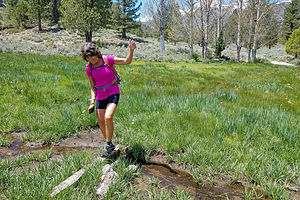 Lolo on the Buckeye Creek TrailContinuing our journey up 395, we decided to grab a campsite at Bridgeport Reservoir Marina and Campground on the Bridgeport Reservoir, a pretty lake with nice views of the Sierra - or as they say, “Killer fishin, killer views.”
Lolo on the Buckeye Creek TrailContinuing our journey up 395, we decided to grab a campsite at Bridgeport Reservoir Marina and Campground on the Bridgeport Reservoir, a pretty lake with nice views of the Sierra - or as they say, “Killer fishin, killer views.”
Next time, we’ll bring fishing gear, but for now, hiking was the activity of the day - as it had been for every day on this trip so far. The Buckeye Creek Trail sounded interesting, so we drove out to the Buckeye Campground where the trail began.
Unfortunately, there wasn’t much “creek” along the Buckeye Creek Trail. I definitely had had visions of meandering alongside a lovely creek for the duration of our hike. Instead after 2.5 miles and still no creek, we bushwhacked down to it to have lunch.
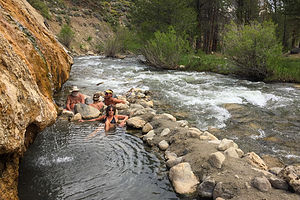 Lolo soaking in Buckeye Hot SpringAfter our hike we decided to take a soak in the Buckeye Hot Springs, so we drove over to the parking area for the springs, just a short distance away at the top of a hill near the Buckeye Campground.
Lolo soaking in Buckeye Hot SpringAfter our hike we decided to take a soak in the Buckeye Hot Springs, so we drove over to the parking area for the springs, just a short distance away at the top of a hill near the Buckeye Campground.
These pools are very different than Keough and Travertine in that they are directly next to a creek, separated from its chilly waters only by man-made rock piles. The source of the spring is on top of the grassy hillside that we were parked atop. The water emerges from the spring at about 140 degrees and flows down, cooling along the way, until it cascades over a cave into the largest pool, forming a nice little waterfall. Additional rock piles separate the hot water area into three separate pools, varying in temperature from 95 to 110 degrees.
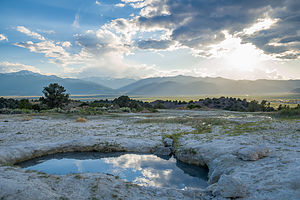 Primitive pool at Travertine Hot SpringHerb and I grabbed our towels and scrambled down the short, steep trail to the pools. We weren’t the only ones with this idea, but there was still plenty of room for us in the middle one with the waterfall. It was nice sitting in the warm pool, listening to the babbling creek flow by.
Primitive pool at Travertine Hot SpringHerb and I grabbed our towels and scrambled down the short, steep trail to the pools. We weren’t the only ones with this idea, but there was still plenty of room for us in the middle one with the waterfall. It was nice sitting in the warm pool, listening to the babbling creek flow by.
That was until Herb’s watch starting beeping with a weather alert. We didn’t believe it at first, but within minutes the winds picked up and the sky darkened. We quickly dried ourselves off and scurried back up the steep hill to avoid being caught in a storm. Herb was quite impressed with his watch - it must measure a drop in barometric pressure.
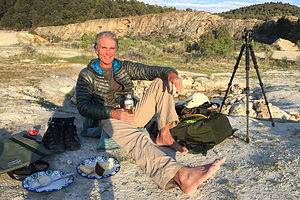 Herb at TravertineLater that evening when the weather cleared, we drove over to Travertine, Herb’s favorite hot spring. They really are quite beautiful - fed from water trickling over the edge of a colorful, “travertine”-stained rock formation that rises above them. Rock piles separate the water into three separate pools, with water flowing from one pool to the next, decreasing in temperature as it goes along. The rightmost pool, which has stone sides to sit on, is about 105 degrees; the middle pool also has stone sides and is about 100 degrees; and the leftmost pool has a mushy mud bottom and is about 90 degrees. As usual, these pools were full of people - after all, it was a Friday night after work.
Herb at TravertineLater that evening when the weather cleared, we drove over to Travertine, Herb’s favorite hot spring. They really are quite beautiful - fed from water trickling over the edge of a colorful, “travertine”-stained rock formation that rises above them. Rock piles separate the water into three separate pools, with water flowing from one pool to the next, decreasing in temperature as it goes along. The rightmost pool, which has stone sides to sit on, is about 105 degrees; the middle pool also has stone sides and is about 100 degrees; and the leftmost pool has a mushy mud bottom and is about 90 degrees. As usual, these pools were full of people - after all, it was a Friday night after work.
However, these are not the only pools to soak in. The whole area around the springs is very active geothermally, so new springs are continuously erupting forming new pools. Fortunately, Herb’s favorite pool-for-two, with the great mountain views, was still there, but unfortunately, it wasn’t very warm. That’s the challenge with natural hot springs - their status is always changing.
Oh well, the view was still good.
Description
Buckeye Hot Springs, near Bridgeport, CA, are considered by some to be the most beautiful pools in the eastern Sierra. The pools are quite unique in that they sit directly next to chilly Buckeye Creek. The two main sources emerge from the side of a steep grassy hillside at about 140 degrees and flow downward, cooling along the way before cascading over a cave in a mini-waterfall formation into the largest pool. The hot water is captured by man-made rock piles alongside the creek, creating three pools of varying temperature in the 95 to 110 degree range. Since the creek water cycles through the pools, they are cleaner than those at Travertine. The trail down to the creek from the parking lot is quite steep. As with most hot spring pools in the Sierra, this one is clothing optional.
Travertine Hot Springs
There are many natural hot springs in the Sierra, but the Travertine Hot Springs are one of the prettiest and the easiest to get to. They are located just south of the town of Bridgeport along Route 395. To reach the springs, turn onto Jack Sawyer Road, then left again onto a marked, but somewhat rutted, dirt road.
There are several pools at Travertine. Right next to the parking area is a developed pool, which is the hottest of the pools in the area. There were even rugs placed around it to cushion the hard surface.
A short way down the trail are the lower three pools, which are fed from water trickling over the ridge of a colorful rock formation that rises above them. The beautiful tan, cream and rust colors of the rock are the result of a form of limestone, called “travertine” that is deposited by the mineral-laden hot springs. The water flows from one pool to the next decreasing in temperature as it goes along. The first pool is about 105 degrees, while the last, which is the largest and shallowest, is only about 90 degrees.
A little past the main pools there are a few more primitive pools that are much more private. The whole area around the springs is very active geothermally, and new springs are continuously erupting.
There are wonderful views of the Sierra while you bathe in one of its pools, sitting along a rocky ledge or in the mud that lines their bottoms. The mud is slightly sulfuric and soothing to the skin.
The area is designated “clothing optional,” but most people wear bathing suits.
Mono Lake
Monday, May 28, 2018 - 9:00am by Lolo60 miles and 1.25 hours from our last stop - 1 night stay
Travelogue
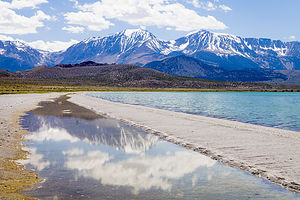 Stroll on Mono Lake south shoreThe kids left in the morning to head back to the city. Since snow in the Sierra was no longer a threat, they took the Tioga Pass Road through Yosemite, the shortest, and also the most scenic, route back to the Bay Area.
Stroll on Mono Lake south shoreThe kids left in the morning to head back to the city. Since snow in the Sierra was no longer a threat, they took the Tioga Pass Road through Yosemite, the shortest, and also the most scenic, route back to the Bay Area.
Not having jobs to get back to, Herb and I had the luxury of not having to drive home on Memorial Day. Instead we could take our time cruising north on 395 before heading west towards home - retirement is so great!
Herb loves Mono Lake, and never seems to get enough of its otherworldly landscape of “tufa castles” that rim the lake. So, we got a campsite at nearby Mono Vista RV Park, a campground we have stayed at on numerous occasions while exploring up and down Highway 395.
Besides being the oldest lake in North America, Mono Lake is extremely unique, because of the massive amounts of salt and minerals that flow into it from Sierra streams and have no way out except through evaporation—similar to the Great Salt lake in Utah. However, Mono Lake has something the Great Salt Lake doesn’t – “tufa castles,” which built up over thousands of years from the calcium-carbonate deposits accumulating in the lake. Normally they would just be hidden beneath the water, but as lake levels dropped, these extraordinary-looking knobs, spires, and minarets became exposed, some of them rising as high as 30 feet above the surface—and they do look like castles.
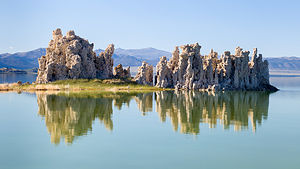 Reflecting on tufasThe largest concentration of them can be found along the southern shore of the lake at the South Tufa State Reserve, just ½ mile west of Navy Beach.
Reflecting on tufasThe largest concentration of them can be found along the southern shore of the lake at the South Tufa State Reserve, just ½ mile west of Navy Beach.
We’ve pretty much seen the main tufa areas, both by kayak and by hiking, but Herb still wanted to find the “sand tufas” which he had seen in the movie about Mono Lake played at the Visitor Center. We asked a ranger where we could find them, and he told us to drive towards Navy Beach, hanging a right on a dirt road to a small parking lot. From there we should just walk east along the lakeshore.
We did as told and soon found ourselves in a small parking lot with just one other car. From there we walked along the beach. There were always more tufas in the distance, so we kept forging on, hoping these would be the elusive sand ones. But alas, they were just your everyday tufas, still spectacular, but nothing different from what we had seen on our past visits.
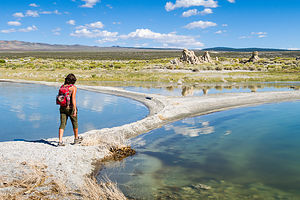 Lots of circlesAt the 2 ½ mile point, we decided to turn around and head back. Rather than walk on the harder sand further from the lake, we decided to walk along a sand spit between the lake and a small stream of water. Herb had me go ahead because he likes to use me in his photos to give some sense of scale.
Lots of circlesAt the 2 ½ mile point, we decided to turn around and head back. Rather than walk on the harder sand further from the lake, we decided to walk along a sand spit between the lake and a small stream of water. Herb had me go ahead because he likes to use me in his photos to give some sense of scale.
Or, was that the real reason? Before long my feet began to sink a little, but stupidly I plowed on, only to sink even further. Soon I found myself sunk up to my knees in quicksand. As I started to sink, I put out my left hand to stop myself, but it sunk into the sand as well. Unfortunately, that hand was clutching my cell phone which was now wet and covered with sand.
Herb jumped to my rescue, and by that I mean he started taking pictures of me struggling to extricate myself. Big help! I eventually got myself to firmer ground and tried getting the sand off my phone. Herb made me immediately turn it off to hopefully save it from getting its inner workings water damaged. Since the phone was my only camera, that was the end of my picture taking for the day.
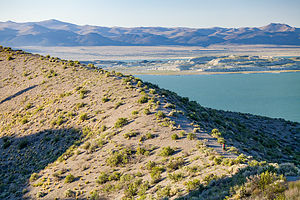 Panum Crater RidgeSurprisingly I wasn’t muddy at all. It wasn’t really mud at all, but just really soft, wet sand. We made it back to the car without any further calamities.
Panum Crater RidgeSurprisingly I wasn’t muddy at all. It wasn’t really mud at all, but just really soft, wet sand. We made it back to the car without any further calamities.
While driving back to the campground, we decided stop and do a hike which we had done on a previous visit - the trail up to and along the rim of Panum Crater, a perfect example of a rhyolitic plug-dome volcano. Panum Crater is pretty small by volcanic standards – 220 feet high and 2,000 feet across. It last erupted in 1325 AD.
The entire hike around the rim is about 2 miles, and the views along the way of Mono Lake and the snow-covered Sierra are really beautiful.
Description
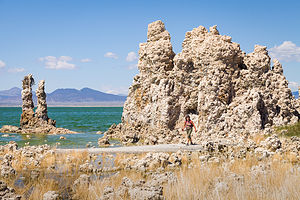 Lolo of the tufasMono Lake is located just off Highway 395 near the town of Lee Vining, California, 13 miles east of Yosemite National Park. Mono Lake is extremely unique. First of all, at over 1 million years of age, it is one of the oldest continuously existing lakes in the continent. Secondly, it is about 2 ½ times as salty as the sea and about 80 times as alkaline. This is because Sierra streams flow into Mono Lake bringing trace amounts of salts and minerals, but the lake has no outlet other than evaporation. As a result, the concentration levels of salts and minerals keeps growing each year. Thirdly, and the main reason Mono Lake is so popular, are the hundreds of spectacular “tufa towers” that rise from the lake. These intriguing calcium-carbonate sculptures were formed beneath the water when carbonates in the water combined with calcium from freshwater springs feeding into the lake. As lake levels dropped, these extraordinary-looking knobs, spires, and minarets became exposed. Most of the towers visible in the lake are from 200 to 900 years old and rise as high as 30 feet above the water.
Lolo of the tufasMono Lake is located just off Highway 395 near the town of Lee Vining, California, 13 miles east of Yosemite National Park. Mono Lake is extremely unique. First of all, at over 1 million years of age, it is one of the oldest continuously existing lakes in the continent. Secondly, it is about 2 ½ times as salty as the sea and about 80 times as alkaline. This is because Sierra streams flow into Mono Lake bringing trace amounts of salts and minerals, but the lake has no outlet other than evaporation. As a result, the concentration levels of salts and minerals keeps growing each year. Thirdly, and the main reason Mono Lake is so popular, are the hundreds of spectacular “tufa towers” that rise from the lake. These intriguing calcium-carbonate sculptures were formed beneath the water when carbonates in the water combined with calcium from freshwater springs feeding into the lake. As lake levels dropped, these extraordinary-looking knobs, spires, and minarets became exposed. Most of the towers visible in the lake are from 200 to 900 years old and rise as high as 30 feet above the water.
A good place to start your visit is at the Mono Basin Scenic Area Visitor Center, located just off Highway 395, north of Lee Vining, where you will find exhibits about both the natural and human history of the Mono Basin.
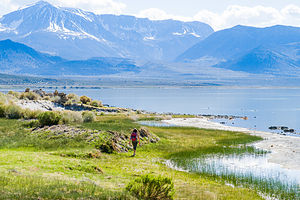 Lovely Mono LakeOne of the best places to view the tufas is at the Mono Lake Tufa State Reserve along the southern shoreline of the lake. The trailhead for the south tufa castles and Navy Beach is at the edge of the parking lot. During the summer, rangers lead walking tours 3 times a day (10am, 1pm, and 6pm), but if your not lucky enough to catch one of these, there are plenty of informative signboards along the trail. A short walk along the mile-long trail brings you to the strange and fanciful tufa castles at Navy Beach. A swim in the buoyant waters of Mono Lake is a memorable experience, as long as you are willing to step through the millions of harmless alkali flies that line the water’s edge. It’s fun to watch what at first looks like black sand part before you.
Lovely Mono LakeOne of the best places to view the tufas is at the Mono Lake Tufa State Reserve along the southern shoreline of the lake. The trailhead for the south tufa castles and Navy Beach is at the edge of the parking lot. During the summer, rangers lead walking tours 3 times a day (10am, 1pm, and 6pm), but if your not lucky enough to catch one of these, there are plenty of informative signboards along the trail. A short walk along the mile-long trail brings you to the strange and fanciful tufa castles at Navy Beach. A swim in the buoyant waters of Mono Lake is a memorable experience, as long as you are willing to step through the millions of harmless alkali flies that line the water’s edge. It’s fun to watch what at first looks like black sand part before you.
Surrounded by volcanic hills, Mono Lake is also a geologist's paradise. The two major islands in the lake are actually volcanic domes. The large black island, which the Kuzedika Indians named Negit, meaning “blue-winged goose,” erupted about 1700 years ago. The white island, which the Native Americans named Paoha, meaning “spirits of the mist,” erupted 250 years ago.
Bird watching and photography are other popular activities at Mono Lake.
Bishop
Thursday, May 24, 2018 - 8:30pm by Lolo155 miles and 3 hours from our last stop - 4 night stay
Travelogue
Day 1 - Arrival
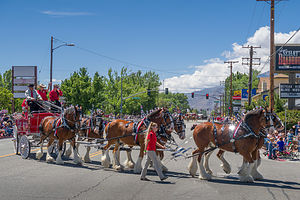 Mule Day ParadeIf it wasn’t for the kids wanting to take advantage of the long Memorial Day Weekend to go to a rock climbing destination, Herb and I would never have chosen that weekend to spend in Bishop.
Mule Day ParadeIf it wasn’t for the kids wanting to take advantage of the long Memorial Day Weekend to go to a rock climbing destination, Herb and I would never have chosen that weekend to spend in Bishop.
Memorial Day Weekend in Bishop means Mule Days, and with that means crowds of mule enthusiasts - yes, there are thousands of mule enthusiasts. I guess the best way to describe Mule Days is that it is part mule show, part test of skills, and part Wild West Show. Over its 47 year history, it has grown from attracting a crowd of 200 to becoming an international world class event bringing in more than 30,000 fans. Over the course of a week, more than 700 mules compete in 181 events including calf roping, steer roping, barrel racing, flat racing, carriage driving, team chariot racing, and even dressage.
Needless to say, getting a campsite anywhere near Bishop during this time is quite a challenge. Fortunately however, I had faced this identical problem 3 years ago and discovered that Brown’s Millpond Campground has an overflow area where they could put us. There was no water or electric, but it would just have to do.
The drive from Red Rock Canyon to Bishop was a lovely 3-hour drive up Highway 395, my favorite highway. Also known as the Eastern Sierra Scenic Byway, Highway 395 runs the entire length of the Sierra Nevada Range, from south of Lone Pine to Carson City. The scenery along the way is breathtaking – snow-covered mountains, incredible lakes teeming with fish, ancient bristlecone forests, natural hot springs, and so much more.
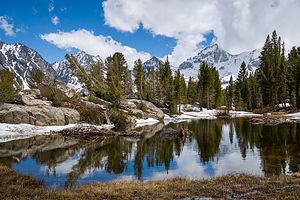 Pond on the way to Ruby LakeWe arrived at Brown’s Millpond Campground late in the afternoon and found that we had been upgraded from overflow into an actual campsite - still no water or electricity, just a higher price.
Pond on the way to Ruby LakeWe arrived at Brown’s Millpond Campground late in the afternoon and found that we had been upgraded from overflow into an actual campsite - still no water or electricity, just a higher price.
The wind was really picking up, but I decided to go out for a run anyway, just 2 miles out and 2 miles back. The way out was fine, and I felt like I was somewhat effortlessly cruising along. When I turned around to head back, I found out why it had seemed so easy up to this point. The wind, which had been at my back the whole first half of my run, was now in my face and practically stopping me dead in my tracks. It was a little scary. Having no choice, I forged on, head down, body bent into the wind, dodging tumbleweed.
When I finally made it back to the motorhome, hair so windblown I looked like a crazy woman, I found a contented Herb lounging in the back of the motorhome, listening to music and drinking a beer. Trying to keep a straight face, he asked “How was your run?” I just shook my very dishevelled head.
Day 2 - Hike to Ruby Lake and Tommy and Erin Arrive
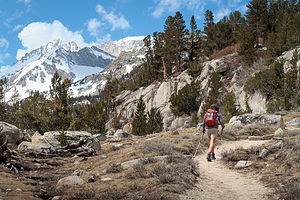 Hike to Ruby LakeIt was Friday, and the kids wouldn’t be arriving until late tonight after work, so we had a full day to entertain ourselves.
Hike to Ruby LakeIt was Friday, and the kids wouldn’t be arriving until late tonight after work, so we had a full day to entertain ourselves.
We decided to hike to Ruby Lake, a beautiful alpine lake set in a hanging cirque. To get to the trailhead we drove north on Highway 395 for 18 miles to Tom’s Place, where we made a left onto Rock Creek Road. From there it was 10.5 miles to the end, at the Mosquito Flats parking area and trailhead for the Ruby Lake hike.
Although only 4.5 miles round trip, the trailhead is at 10,200 feet and the lake is another 1,000 feet higher. The distance and elevation gain was not a big deal, but the high elevation would make it more challenging, especially since we had had no time to acclimate.
After parking the car we headed out into the Little Lakes Valley, with lovely views of the snow-covered Sierras all around us. In fact, we would soon be encountering some of that snow up close and personal.
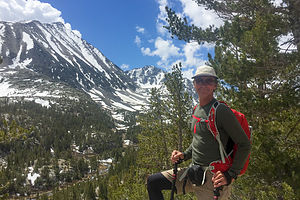 Sierra HerbAfter about ½ mile, we came to a junction and took the trail to the right heading up to Mono Pass. Before long we were crossing small patches of snow. I was glad I listened to Herb and brought along my trekking poles because the snow kept getting deeper and deeper.
Sierra HerbAfter about ½ mile, we came to a junction and took the trail to the right heading up to Mono Pass. Before long we were crossing small patches of snow. I was glad I listened to Herb and brought along my trekking poles because the snow kept getting deeper and deeper.
Two miles in, we began looking for the spur trail to Ruby Lake. We managed to find it, but it was impassable because of the snow, which we were now postholing through up to our knees. While we were standing around, a bit confused as to how and if we should proceed, two young hikers came along and said they were going to go up and scramble along the rocky ridge to the lake.
We followed behind, a bit slower, and soon came to a view from above of Ruby Lake. Rather than the emerald waters we had been promised in the hiking book, the lake was completely frozen. However, ringed by a granite cirque, it was still quite impressive.
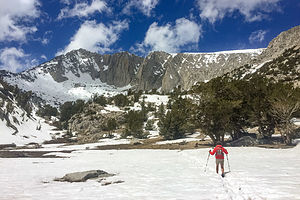 A little more snow than anticipatedWe decided that it made no sense to posthole our way down to it, so we enjoyed a picnic lunch from above, and then made our way back from whence we came.
A little more snow than anticipatedWe decided that it made no sense to posthole our way down to it, so we enjoyed a picnic lunch from above, and then made our way back from whence we came.
It would have been nice to have gotten all the way down to the lake, but you just never know what the conditions are going to be in the Sierra, no matter what time of year.
Tommy and Erin arrived about 10:00 that night, after a quick stop to boulder in the Buttermilks, but Andrew and Celeste got a much later start and spent the night in South Lake Tahoe. They would join us in the morning.
Rather than 6 of us trying to squeeze into the Lazy Daze, Tommy and Erin now had their own camper van, so they had left the nest. Andrew and Celeste are getting a camper van as well, but for now, they would stay with us, probably for the last time. Saying it that way makes me feel a little sad - the end of an era. But more room for all of us!! Yeay!
Day 3 - Mule Day Parade, Andrew and Celeste’s Arrival, and Bouldering in the Buttermilks
>
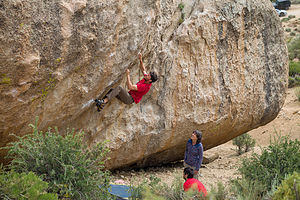 Tommy bouldering in the ButtermilksUsually our time with the boys and their girlfriends on these mini-vacations is spent rock climbing, but this time we were dealing with several injuries. Herb had a bruised or possible fractured rib and Celeste had a very bad high ankle sprain and was wearing a boot. That left Erin and Tommy (one complete pair) and Andrew and Mommy (not exactly Andrew’s ideal set up).
Tommy bouldering in the ButtermilksUsually our time with the boys and their girlfriends on these mini-vacations is spent rock climbing, but this time we were dealing with several injuries. Herb had a bruised or possible fractured rib and Celeste had a very bad high ankle sprain and was wearing a boot. That left Erin and Tommy (one complete pair) and Andrew and Mommy (not exactly Andrew’s ideal set up).
While waiting for Andrew and Celeste’s arrival, we took a ride over to Cardinal Pinnacle to check out a multi-pitch trad climb that Tommy and Erin planned to do the following morning. It was one of Bishop’s must do classic climbs. They didn’t want to be away from all of us the whole day tomorrow, so they wanted to make sure they knew how to find the approach to it and the actual start of the climb itself, so they wouldn’t waste time in the morning.
The scramble up the rocks to the base of the climb was a bit too much for Herb’s sore rib, so we went up about halfway and then sat and waited for Tommy and Erin’s return. They came back beaming and excited about climbing it the following day.
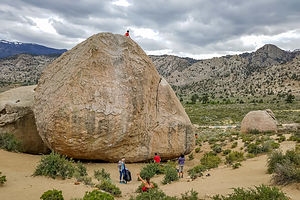 Tiny Andrew atop High Plains DrifterWe still had time before Andrew and Celeste arrived, so we stopped in town to see the end of the Mule Day Parade. We had never seen it before and it was quite a scene - people in cowboy hats and attire as far as the eye could see, lots of American flags, mules pulling carts, prancing Clydesdale horses, cute little cowgirls on ponies, giant pooper scooper trucks to clean the streets, etc. It was a hoot!
Tiny Andrew atop High Plains DrifterWe still had time before Andrew and Celeste arrived, so we stopped in town to see the end of the Mule Day Parade. We had never seen it before and it was quite a scene - people in cowboy hats and attire as far as the eye could see, lots of American flags, mules pulling carts, prancing Clydesdale horses, cute little cowgirls on ponies, giant pooper scooper trucks to clean the streets, etc. It was a hoot!
Now that we were all feeling in the holiday spirit, we decided to welcome Andrew and Celeste at the campground with a traditional Memorial Day BBQ - complete with hamburgers, hot dogs, corn on the cob, and all the fixin’s.
However, since this was a climbing trip after all, immediately upon completion, we headed over to the Buttermilks, a world-famous bouldering destination just 20 minutes from our campground, the last part of which is along a 3 ½ mile bumpy, washboard road. It’s an amazing landscape - hundreds of huge boulders (or more technically, glacial erratics) strewn along a vast hillside with the snow-capped Sierra in the background.
 Lolo on her projectEven if you’re not bouldering (as half of our party due to injuries was not), it’s a great place to just hang out, enjoy the scenery, and watch people puzzle out the “problem” of getting to the top of a boulder - and then, even more interestingly, puzzle out how to get back down again.
Lolo on her projectEven if you’re not bouldering (as half of our party due to injuries was not), it’s a great place to just hang out, enjoy the scenery, and watch people puzzle out the “problem” of getting to the top of a boulder - and then, even more interestingly, puzzle out how to get back down again.
I’m not a particularly big fan of bouldering, because I don’t like to fall - even three feet. Plus, I get a bit nervous watching the boys and their girlfriends boulder, because unlike “trad” or “sport” climbing, there are no ropes. Rather, crash pads are placed on the ground to soften the climber’s fall. In addition to the pads, other climbers stand at the bottom with arms extended upward to catch or slow the climber down if he falls. The reasoning behind the lack of ropes is that bouldering routes are much shorter than “trad” or “sport” routes. Well, generally that is true, but the Buttermilks are known for their especially tall boulders, some as high as 45 feet.
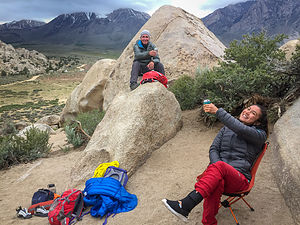 The injured crew spectatingAndrew and Tommy gave me a boulder “problem” to work on. The word “problem” is used in bouldering because climbers often spend weeks and even months, working out all the moves to complete a particular bouldering route. I think they were pretty proud of me when I completed my boulder problem the first try - I think they gave me a pretty easy one. Even so, I had to drop down about 5 feet from the top, so they very gallantly grabbed my hips and lowered me down like I was in an elevator. What service!
The injured crew spectatingAndrew and Tommy gave me a boulder “problem” to work on. The word “problem” is used in bouldering because climbers often spend weeks and even months, working out all the moves to complete a particular bouldering route. I think they were pretty proud of me when I completed my boulder problem the first try - I think they gave me a pretty easy one. Even so, I had to drop down about 5 feet from the top, so they very gallantly grabbed my hips and lowered me down like I was in an elevator. What service!
Andrew and Tommy spent some time working on a boulder called High Plains Drifter, a . At 35 feet, it was a little too high for my comfort. They reassured us that the tough part of the climb was at the bottom and it got increasingly easier as it got higher. Still, it did make us quite nervous watching them do it. The photos afterwards made it look even worse.
Andrew, Tommy, and Erin played around on a few more boulders while Herb and Celeste (the injured) and I (still basking in the glory of my completed “project”) spectated. We didn’t mind - the celebratory beers were cold and the sun was just starting to dip behind the snow-capped Sierras. The lighting was incredible!
Afterwards, we drove back into town and had dinner at the Mountain Rambler brewery, a popular hangout for climbers at the end of a day on the rocks.
Day 4 - Lots of climbing - Cathedral Pinnacle (Tommy and Erin), Alabama Hills, and Buttermilks again
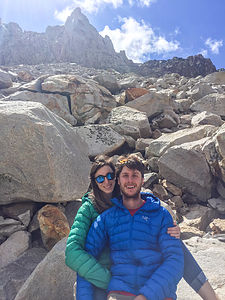 Tommy and Erin excited about their next day climb up Cardinal PinnacleIt was a little challenging figuring what to do when 33% of the group is injured, but I think we had a pretty good plan.
Tommy and Erin excited about their next day climb up Cardinal PinnacleIt was a little challenging figuring what to do when 33% of the group is injured, but I think we had a pretty good plan.
As per plan, Tommy and Erin headed out early to climb Cardinal Pinnacle, the classic 3-pitch climb they had scouted out yesterday. Afterwards, they would meet up with us.
The rest of us got in the car and drove down to the Alabama Hills in Lone Pine, where the scenery is beautiful and the approach to the climbs are easy, even for someone in a boot. Although the drive was long (about an hour), the trip along the 395 corridor is always a treat, especially when the Sierra Mountains are topped with snow.
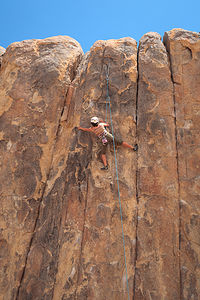 Lolo hits the Alabama HillsEven if you’ve never been to the Alabama Hills, if you’ve ever watched an old Western, you’ve probably seen its beautiful scenery. Because of its dramatic landscape and proximity to Hollywood (3 hours), this area has been the setting for dozens of Hollywood westerns, TV shows, and commercials, right up to the present.
Lolo hits the Alabama HillsEven if you’ve never been to the Alabama Hills, if you’ve ever watched an old Western, you’ve probably seen its beautiful scenery. Because of its dramatic landscape and proximity to Hollywood (3 hours), this area has been the setting for dozens of Hollywood westerns, TV shows, and commercials, right up to the present.
However, finding old movie sets was not what we were here for. Today Andrew and I were climbing buddies (poor Andrew!) and there were hundreds of oddly-shaped boulders and towers just asking to be climbed. And they were so easy to get to.
Several dirt side roads branch off Movie Flat Road and lead right up to the base of many of them. Too often when we climb with the boys, we have to hike and rock scramble for miles to get to the start of a climb. Here I could practically start from the hood of our car.
 Andrew victoriousI have to give Andrew a lot of credit allowing me to be his climbing partner for the day. He was so patient, finding climbs within my grade and encouraging me to keep trying. Talk about role reversal.
Andrew victoriousI have to give Andrew a lot of credit allowing me to be his climbing partner for the day. He was so patient, finding climbs within my grade and encouraging me to keep trying. Talk about role reversal.
Poor Celeste was itching to get on the rock. Probably somewhat foolishly, she removed her boot and did one - it was an easy one for her, but still probably not a good idea with a badly sprained ankle.
Towards mid-afternoon, as so often happens, dark clouds began moving in over the mountains,. We immediately thought of Tommy and Erin and hoped that they were not experiencing a storm during their climb. Neither they nor we had cell coverage so we were just going to have to wait to find out.
Rather than have them drive all the way down to the Alabama Hills to meet up with us, only to be greeted by rain, we decided to head north up 395 and try to contact them on the way.
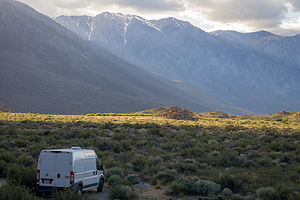 Tommy's new camper vanI confess to being a little worried about them, so I was so glad when they picked up the phone. They were in a coffee shop in Bishop. They had finished the climb just as the rain was starting - in fact, they were the only party that made it to the top that day, as everyone else had to retreat back down to miss the storm. We decided to meet up at the coffee shop.
Tommy's new camper vanI confess to being a little worried about them, so I was so glad when they picked up the phone. They were in a coffee shop in Bishop. They had finished the climb just as the rain was starting - in fact, they were the only party that made it to the top that day, as everyone else had to retreat back down to miss the storm. We decided to meet up at the coffee shop.
When we saw them, they were absolutely beaming. They said that the climb, which is a Bishop Classic, had been awesome.
There was still a few more hours of daylight, so rather than go back to the campground to relax like normal people, we went back to the Buttermilks to climb some more.
Good decision! What a fun evening - rocks to climb on, beautiful scenery, great company, much laughter, tasty celebratory beers, lovely sunset over the Sierras! We even got everybody to stand still long enough to memorialize the moment - perhaps the Gaidus 2018 Christmas card!
Boy I’m going to miss these guys when they leave tomorrow.
Description
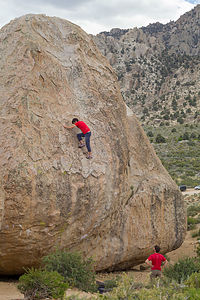 Andrew on High Plains DrifterBishop is my favorite town in the Eastern Sierra. It is located along Highway 395 between the towns of Mammoth Lakes and Big Pine. It lies at the northern end of the Owens Valley with the Sierra Nevada mountains to the east and the White Mountains to the west.
Andrew on High Plains DrifterBishop is my favorite town in the Eastern Sierra. It is located along Highway 395 between the towns of Mammoth Lakes and Big Pine. It lies at the northern end of the Owens Valley with the Sierra Nevada mountains to the east and the White Mountains to the west.
One of the town’s claims to fame is that it is the "Mule Capital of the World," holding a week-long festival each May called Bishop Mule Days. Part mule show, part test of skills, and part Wild West Show, this annual event has been attracting crowds for over its 47 year history, growing from a crowd of 200 in its early days to becoming an international world class event with more than 30,000 fans. Over the course of a week, more than 700 mules compete in 181 events including calf roping, steer roping, barrel racing, flat racing, carriage driving, team chariot racing, and even dressage.
The reason we go to Bishop is for the excellent rock climbing. The three major climbing areas in Bishop include:
The Owens River Gorge is a steep 10 mile long canyon just north of Bishop that is a very popular destination for rock climbing. With 416 sport-climbing and 52 trad routes it is California’s most concentrated sport climbing area. The climbing is on volcanic tuff and features edges, pockets and cracks. Although there is a full range of difficulty level, the best climbs are in the 5.10 to 5.11 range. The most popular walls are located in the Central Gorge – Warm Up Wall, the Pub, the Social Platform, and the Great Wall of China, which feature tons of 5.8 to 5.11 sport routes. Summers get a bit too hot to climb in the gorge.
Buttermilk Country, one of California’s premier bouldering destinations, is located southwest of Bishop along the western edge of the Owens Valley. These massive glacial erratic boulders sit in the foothills of the Sierra Nevada under an impressive backdrop of high peaks just a mere four miles to the west. There are 243 bouldering routes, many of which top out at over 20 feet.
The Volcanic Tablelands, another popular bouldering destination, lie just north of Bishop in an area where the floor of the Owens Valley rises abruptly, forming a 300 foot-high volcanic plateau. Along the southern tip of the plateau there are numerous canyons and washes containing thousands of boulders. The Happy Boulder area with 418 routes and the Sad Boulder area with 187 routes are the most popular. Because of its 4,500 foot elevation, the Volcanic Tablelands are climbable year round.
Red Rock Canyon State Park
Wednesday, May 23, 2018 - 8:30pm by Lolo407 miles and 7.5 hours from our last stop - 1 night stay
Travelogue
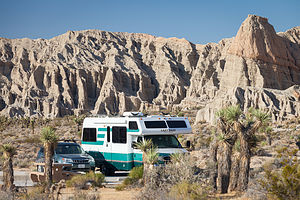 Camping in Red Rock CanyonAlthough 2 ½ hours longer, we decided to take the southern route to Bishop to avoid encountering snow along the mountain passes. I5 south to Bakersfield is a bit monotonous to say the least, but a lot less stressful than the alternatives.
Camping in Red Rock CanyonAlthough 2 ½ hours longer, we decided to take the southern route to Bishop to avoid encountering snow along the mountain passes. I5 south to Bakersfield is a bit monotonous to say the least, but a lot less stressful than the alternatives.
Rather than go the whole way, we decided to stop for the evening at Red Rock Canyon State Park, a desert park we have not been too, known for its reddish desert cliffs, buttes, and spectacular rock formations.
The campground is first-come-first-served, and we were far ahead of the Memorial Day crowd - if there ever is one at this remote park - so we had no trouble getting a nice campsite, set against a backdrop of colorful cliffs. The sites are quite large with a lot of space between them, making for a very pleasant experience.
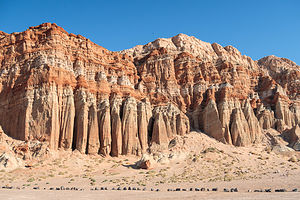 The Red Cliffs of Red Rock CanyonBefore dinner, we took a stroll around the campground loop, enjoying the colorful rock formations along the way.
The Red Cliffs of Red Rock CanyonBefore dinner, we took a stroll around the campground loop, enjoying the colorful rock formations along the way.
The next morning, before continuing on to Bishop, we decided to do a few hikes in the park. We drove the short distance down Highway 14 to the Red Cliffs Natural Preserve, a hikers-only section of the state park.
From the parking lot we set off on the Red Cliffs trail, which was really more of an old jeep road than a trail, with great views of the 300-foot high columnar red cliffs the park is known for and the El Paso Mountains in the distance - oh, and some Joshua Trees along the way. There was a lot of scenery packed into our 2.5 mile out and back hike.
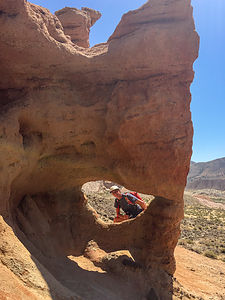 Herb peeking through window along Hagan Canyon TrailSince we had our Subaru Forester, which we now always tow behind the Lazy Daze, we thought it would be fun to do a bit of off-roading in the park. We headed out from the Red Cliffs parking lot on a dirt road through Iron Canyon, but were unable to get too far before being stopped by a gate. Much of the Scenic Cliffs area is closed each year from February 1 to July 1 to protect nesting birds of prey.
Herb peeking through window along Hagan Canyon TrailSince we had our Subaru Forester, which we now always tow behind the Lazy Daze, we thought it would be fun to do a bit of off-roading in the park. We headed out from the Red Cliffs parking lot on a dirt road through Iron Canyon, but were unable to get too far before being stopped by a gate. Much of the Scenic Cliffs area is closed each year from February 1 to July 1 to protect nesting birds of prey.
So we got back on Highway 14, drove north a bit, and took another dirt road with the hopes of getting to an overlook, marked on the map we had gotten at the Visitor Center. However, trails weren’t marked very well, so after driving for what seemed like far too long, we realized we had overshot our goal. Eventually we found our way back to Highway 14 and headed back to the campground to squeeze in one more hike before the noon-time checkout.
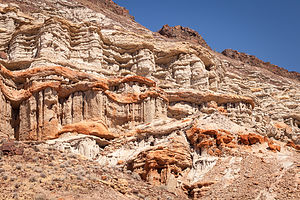 Along the Hagan Canyon TrailWe parked at the Hagan Canyon trailhead right outside the entrance to the campground. It was even shorter than the Red Cliffs hike - only 1 mile - but it too packed a lot of awesome scenery into that distance.
Along the Hagan Canyon TrailWe parked at the Hagan Canyon trailhead right outside the entrance to the campground. It was even shorter than the Red Cliffs hike - only 1 mile - but it too packed a lot of awesome scenery into that distance.
Many cowboy westerns were filmed amongst these beautiful sandstone cliffs and interesting rock formations, such as “Zorro Rides Again", "Law and Order" starring Ronald Reagan, "The Ten Commandments", "Jurassic Park", and "Beneath the Planet of the Apes".
Noon was quickly approaching - time to move our motorhome out of the camping site and move on towards Bishop.
Description
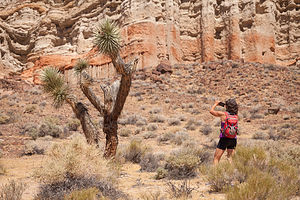 Hagan Canyon TrailRed Rock Canyon is a California state park located 120 miles north of Los Angeles, via I5 and Highway 14, where the southernmost tip of the Sierra Nevada converges with the El Paso mountain range.
Hagan Canyon TrailRed Rock Canyon is a California state park located 120 miles north of Los Angeles, via I5 and Highway 14, where the southernmost tip of the Sierra Nevada converges with the El Paso mountain range.
The park features reddish desert cliffs and spectacular rock formations with dramatic shapes and vivid colors. Miles of hiking trails meandering through the dramatic landscape of the park. There is also a vast network of dirt primitive roads for 4WDing.
There is a first-come, first-served campground in the park with 50 primitive sites. The sites are spacious and tucked up against the base of the dramatic desert cliffs.
Suvarnabhumi Airport Hotel
Wednesday, March 28, 2018 - 10:00pm by Lolo miles and hours from our last stop - 1 night stay
Travelogue
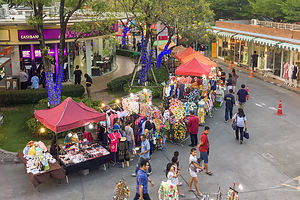 Suvarnabhumi Night MarketToday we began the first leg of our long journey home. We flew from Phuket back to Bangkok and took a taxi to the Golden Jade, a hotel in Suvarnabhumi, close to the airport, and I guess you could call it a “suburb” of Bangkok.
Suvarnabhumi Night MarketToday we began the first leg of our long journey home. We flew from Phuket back to Bangkok and took a taxi to the Golden Jade, a hotel in Suvarnabhumi, close to the airport, and I guess you could call it a “suburb” of Bangkok.
The hotel wasn’t great, and the neighborhood around it wasn’t very appealing either, so we had no great expectations for our last day in Thailand. However, we did have to eat, so we looked on Tripadvisor and found that there were several choices just a little over a half mile west on Lat Kabrang Road.
While we couldn’t find the restaurant we were originally searching for (I think it had closed), we did find a very pleasant outdoor night market with upscale stores and restaurants, as well as numerous food vendors selling very affordable and delicious looking food.
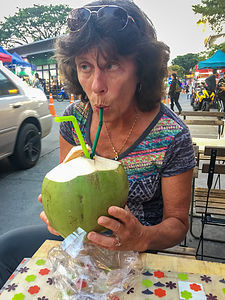 Last item on Lolo's bucket listBy this point, I had an extreme craving for two things: non-Thai food (not that it isn’t wonderful, but I did miss home) and wine (no more Chang beer please). That made our choice for dinner quite obvious - Scoozi Pizza, a pretty fancy looking (white tablecloths Italian restaurant that served wine. I was pretty excited. It was relatively empty, because we were really between meals, as it was only 4:00 pm, but the pizza was quite good and the wine (which could probably have been any form of grape by this time) was exquisite.
Last item on Lolo's bucket listBy this point, I had an extreme craving for two things: non-Thai food (not that it isn’t wonderful, but I did miss home) and wine (no more Chang beer please). That made our choice for dinner quite obvious - Scoozi Pizza, a pretty fancy looking (white tablecloths Italian restaurant that served wine. I was pretty excited. It was relatively empty, because we were really between meals, as it was only 4:00 pm, but the pizza was quite good and the wine (which could probably have been any form of grape by this time) was exquisite.
While eating, we happened to glance out the window at the wine store next door, to which we were close enough to see the prices of bottles on their shelves. I looked for something familiar and spotted a bottle of Kendall Jackson chardonnay with a price tag of 2500 bahts, which is the equivalent to about $80. Now, I am far from a wine snob, despite living in Sonoma Valley, but our house wine is Kendall Jackson chardonnay, and I buy it at Safeway (after discount) for $8.99. No wonder we hadn’t been drinking wine in Thailand. It is exorbitantly expensive!
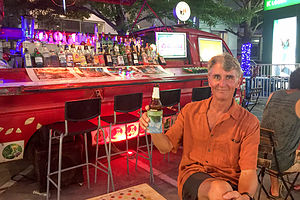 Herb enjoyinga beer at the Suvarnabhumi Night MarketAfter our early dinner, we strolled around the market and observed it getting more and more crowded as the dinner hour approached - not with tourists, but with people from local neighborhoods, stopping by to eat or pick up dinner to bring home. This was the closest I had gotten to feeling a similarity to home - a suburban community going, coming home from work, and going out for some socialization and a bite to eat. I could picture this being somewhere in a U.S. city.
Herb enjoyinga beer at the Suvarnabhumi Night MarketAfter our early dinner, we strolled around the market and observed it getting more and more crowded as the dinner hour approached - not with tourists, but with people from local neighborhoods, stopping by to eat or pick up dinner to bring home. This was the closest I had gotten to feeling a similarity to home - a suburban community going, coming home from work, and going out for some socialization and a bite to eat. I could picture this being somewhere in a U.S. city.
Making that feeling of home even stronger, the music being played was classic rock from the 80s. Herb and I sat out an outdoor bar, had a drink, and people watched. I left briefly to try something that was still left on my Thailand bucket list - drinking straight from a coconut. I was so excited, but soon found out that warm coconut milk is overrated - at least for me. I should have chosen one of the cold coconut smoothies.
It was a much better airport hotel experience than we had anticipated. Every experience in Thailand up to this point had felt so unique and exotic, but there was a certain familiarity in this market that gave us a jump start on our transition back home.
Patong Beach, Phuket Island
Sunday, March 25, 2018 - 1:15pm by Lolo0 miles and 0 hours from our last stop - 3 night stay
Travelogue
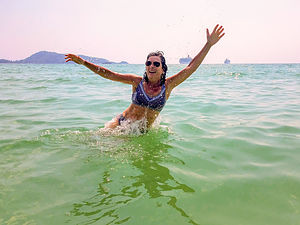 Lolo really enjoying Patong BeachWe were now on the do-it-yourself part of our Thailand trip - no more Udom and his Gate1 flag guiding us through space, no more air conditioned bus delivering us everywhere we needed to go, no more giant buffet meals and luxurious hotels. It was kind of scary but liberating at the same time.
Lolo really enjoying Patong BeachWe were now on the do-it-yourself part of our Thailand trip - no more Udom and his Gate1 flag guiding us through space, no more air conditioned bus delivering us everywhere we needed to go, no more giant buffet meals and luxurious hotels. It was kind of scary but liberating at the same time.
Being on a group tour had far exceeded our expectations, and if we had to do a guided tour, Thailand was definitely the place to do so -- we could never have seen and learned so much doing a trip like this on our own. Still, we are very used to planning our own trips and being on our own, so we were quite excited about spending three additional days in Thailand, just the two of us.
The Gate1 tour was centered around cities, temples, and culture, which was great. However, we wanted to end it with some natural beauty, relaxation, and fun. After some research, we chose to add three days onto our trip and spend them on the beautiful island of Phuket.
After spending a good half day finding flights, a hotel, transportation from the airport, and things to do, we had a new-found appreciation for all the planning that Gate1 had done for us on our 11-day tour. It probably would have taken us 11 days of planning to have pulled that off on our own.
Day 1 - Travel to Phuket
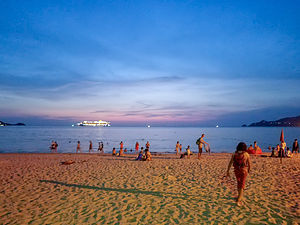 Patong BeachAfter checking out of Le Meridien Chiang Mai, Udom accompanied us on the bus to the Chiang Mai airport to make sure we had no glitches boarding our flight back to Bangkok. Rather than fly back to Bangkok with us, he was continuing on with the part of our group that had signed up for additional days in Vietnam, Laos, and Cambodia. As much as we loved our Gate1 tour in Thailand, we were glad that we hadn’t signed up for more. 11 days was just about right.
Patong BeachAfter checking out of Le Meridien Chiang Mai, Udom accompanied us on the bus to the Chiang Mai airport to make sure we had no glitches boarding our flight back to Bangkok. Rather than fly back to Bangkok with us, he was continuing on with the part of our group that had signed up for additional days in Vietnam, Laos, and Cambodia. As much as we loved our Gate1 tour in Thailand, we were glad that we hadn’t signed up for more. 11 days was just about right.
Rather than staying in Bangkok for the night, as the rest of the group was, and then coming back to the Bangkok airport the next morning, we had arranged to fly directly to Phuket that same afternoon.
It was a long day, but we arrived at the Charm Resort Phuket, our home for 3 nights, in time to take a sunset walk along the beach, which was only a block away.
After so many days rushing around crowded, smoggy cities, it was nice to just relax and take in some fresher air and ocean breezes.
Day 2 - Relaxing on Patong Beach, sipping cocktails in the hotel pool, and checking out the action on Bangla Road
 Infinity pool at the Charm Resort in PhuketWow! A day totally to ourselves where we could lie guiltlessly in a lounge chair without a single planned activity in sight.
Infinity pool at the Charm Resort in PhuketWow! A day totally to ourselves where we could lie guiltlessly in a lounge chair without a single planned activity in sight.
Armed with kindles and towels, we walked the short distance to Patong Beach, where for about the equivalent of $20, we rented lounge chairs and umbrellas for the day. It was extremely hot, but the water was refreshingly delightful.
 Bangla RoadLater that afternoon, we switched venues to the hotel’s rooftop pool, where we sipped tropical drinks while watching the sun set over the Andaman Sea. It was really quite lovely - very different from our usual travels in a motorhome.
Bangla RoadLater that afternoon, we switched venues to the hotel’s rooftop pool, where we sipped tropical drinks while watching the sun set over the Andaman Sea. It was really quite lovely - very different from our usual travels in a motorhome.
That evening, after dinner and at a restaurant called No. 9, Herb suggested we take a walk along Bangla Road, which is Patong’s infamous nightlife district. Despite its notoriety, I had never heard of it, so it was quite an eye-opening experience. At least it was more pedestrian-friendly than anything we had encountered in Thailand so far, as the road is closed to vehicle traffic at night.
It was quite a scene - neon lights, loud music, go go bars, pole dancers, street performers, and vendors touting ping pong shows (which I don’t want to go into). It certainly was an interesting place to people watch.
Day 3 - Tour of James Bond Island and cave kayaking tour
Phuket has a large Muslim population compared to the rest of Thailand, which is predominantly Buddhist. Our hotel was located near a mosque, so every morning before sunrise, we were awoken to the beautiful and haunting sounds of the morning call to prayer. No need for an alarm clock, as long as this was the time we wanted to get up.
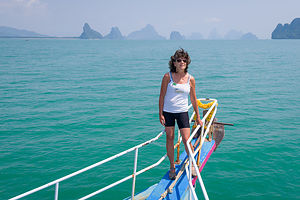 Our James Bond Island TourFortunately, today we did want to get up early because we were expecting to be picked up at our hotel for our big excursion to James Bond Island and kayaking through sea caves. At least, we hoped we were going to be picked up. Things had gotten a little confusing yesterday when we called to confirm our reservation, which we had made through Viator.com a few weeks back.
Our James Bond Island TourFortunately, today we did want to get up early because we were expecting to be picked up at our hotel for our big excursion to James Bond Island and kayaking through sea caves. At least, we hoped we were going to be picked up. Things had gotten a little confusing yesterday when we called to confirm our reservation, which we had made through Viator.com a few weeks back.
First of all, they were supposed to call us to confirm, but they didn’t. When we called them, they kind of gave us the impression that they had no intention of calling us to tell us that the boat we were supposed to go on didn’t have enough people signed up to go out. They then tried to change us to another day, which wouldn’t work for us, before finally saying that they would switch our reservation to another outfitter. It didn’t exactly give us a warm and fuzzy.
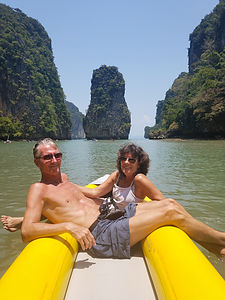 Enjoying being kayaked around beautiful Phang Nga BayHowever, at 7:30 sharp, a van did pick us up at our hotel and bring us to the Kong Khien Pier on the other side of the island, where we would start our adventure. The scene at the pier was utter chaos, with hundreds of people being lined up and somewhat randomly loaded onto about half a dozen boats. We sincerely hoped we were on the right tour.
Enjoying being kayaked around beautiful Phang Nga BayHowever, at 7:30 sharp, a van did pick us up at our hotel and bring us to the Kong Khien Pier on the other side of the island, where we would start our adventure. The scene at the pier was utter chaos, with hundreds of people being lined up and somewhat randomly loaded onto about half a dozen boats. We sincerely hoped we were on the right tour.
It was, and soon we were cruising out to beautiful Phang Nga Bay, which is home to over 100 islands, each more beautiful than the next. Our goal later in the day would be the James Bond Island (Khao Ping Kan), a major tourist attraction ever since it was featured in the 1974 Bond movie, “The Man with the Golden Gun.” Fortunately, the island is now under the protection of Ao Phang Nga National Park, or it would be completely overrun.
But first, we had some sea caves to explore. I had thought when we signed up for this trip, that we would be doing the paddling, but instead we were loaded up in pairs onto inflatable kayaks with someone to paddle for us. I guess exercising while in Thailand just wasn’t meant to be.
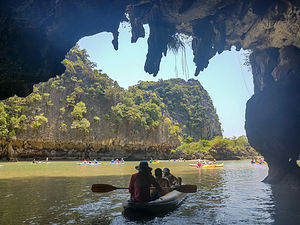 Sea cavesIt was still fun though weaving in and out of the stalactite and stalagmite formations and limestone caves. Fortunately, the tide was low enough for us to squeeze through without too much contorting. I can imagine that you can get in a bit of trouble on your own if you get caught on the wrong side of the caves when the tide comes in.
Sea cavesIt was still fun though weaving in and out of the stalactite and stalagmite formations and limestone caves. Fortunately, the tide was low enough for us to squeeze through without too much contorting. I can imagine that you can get in a bit of trouble on your own if you get caught on the wrong side of the caves when the tide comes in.
Our paddler was lots of fun and always smiling. He even took a corny picture of us through a leaf he pulled out of his pocket that had a heart frame cut out of it.
After kayaking, we were treated to a delicious buffet lunch on the boat, which was actually freshly cooked on board. Once lunch was complete, we pulled up anchor and headed towards the main event - James Bond Island.
Since the island is under national park protection, no big boats are allowed to go too close to the island. Instead, we were transferred to one of the many long-tail boats anchored nearby that were authorized to deliver tourists to the island.
 James Bond IslandIf I thought this morning’s loading of the cruise boats was chaotic, this was insane. Boarding and unboarding the long tails required climbing up on and balancing oneself along the gunnels of the boat, with barely anything to hold on to. There were small children, grandmas, Muslim women in full-length black garments and veils, and people of all shapes and sizes tightroping their way to the front of the boat. It was amazing no one fell in the water.
James Bond IslandIf I thought this morning’s loading of the cruise boats was chaotic, this was insane. Boarding and unboarding the long tails required climbing up on and balancing oneself along the gunnels of the boat, with barely anything to hold on to. There were small children, grandmas, Muslim women in full-length black garments and veils, and people of all shapes and sizes tightroping their way to the front of the boat. It was amazing no one fell in the water.
Herb and I are not big on tourist traps, and that is exactly what this was. It was beautiful enough - a really cool rock formation that rises out of the water, slim at the bottom and big on top, but we had seen many other small islands on the cruise over, just as interesting. However, what those were missing was the aura of James Bond. Needless to say the island was full of souvenir shops and hordes of people.
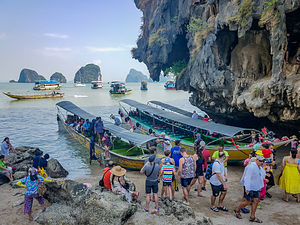 Long-tail boats to get on James Bond IslandOnto the next event with safety precautions thrown to the wind - anchoring and swimming off Koh Hong Island. Jellyfish, some of which can be quite nasty, are often found in these waters, but our faithful crew peeked over the gunnels and said they didn’t see anyway. Oh, ok. Then it must be fine.
Long-tail boats to get on James Bond IslandOnto the next event with safety precautions thrown to the wind - anchoring and swimming off Koh Hong Island. Jellyfish, some of which can be quite nasty, are often found in these waters, but our faithful crew peeked over the gunnels and said they didn’t see anyway. Oh, ok. Then it must be fine.
While most of us just jumped in and hung around near the back of the boat, Herb and a young couple from Germany decided to swim to shore, about ½ mile away. I think Herb swam a lot longer than that because the was doing backstroke and veering off too far to the right. Rather than do the hypotenuse of a triangle, he was doing its two sides.
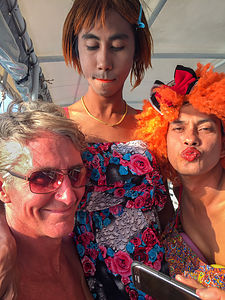 Herb meets ladyboys aboard James Bond boatOn his way back, unbeknownst to us at the time, Herb was stung by a jellyfish, which left a series of red lines across his arm. I was quite concerned and asked the crew what he should do. “Don’t worry,” they said. “If it was the bad kind he would be crying in pain by now.” Well, that was comforting. With my persistence for them to do something, they rubbed some some stuff on his arm that looked entirely too much like soy sauce. Herb was a real trooper though. I would have been much more dramatic.
Herb meets ladyboys aboard James Bond boatOn his way back, unbeknownst to us at the time, Herb was stung by a jellyfish, which left a series of red lines across his arm. I was quite concerned and asked the crew what he should do. “Don’t worry,” they said. “If it was the bad kind he would be crying in pain by now.” Well, that was comforting. With my persistence for them to do something, they rubbed some some stuff on his arm that looked entirely too much like soy sauce. Herb was a real trooper though. I would have been much more dramatic.
As we were returning to port, the crew had one last surprise for us - ladyboys - not exactly the attractive, flamboyant kind we had seen in the Chiang Mai night bazaar, but rather two crew members with flowery dresses and balloons for breasts. They put on quite a show though, shaking it up for the men on board. It was hysterical.
I’d have to say, it was really a fun day and well worth the cost, which I believe was about $90 each.
Chiang Mai
Thursday, March 22, 2018 - 12:30pm by Lolo120 miles and 3 hours from our last stop - 3 night stay
Travelogue
Day 1 - Arrival and Night Bazaar
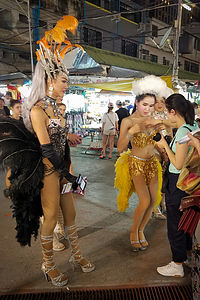 Ladyboys in the Chiang Mai night bazaar After our visit with the Karen Long Neck people, we continued on to Chiang Mai where we would be spending the next three nights at another luxurious hotel - Le Meridien Chiang Mai. I could really get used to this.
Ladyboys in the Chiang Mai night bazaar After our visit with the Karen Long Neck people, we continued on to Chiang Mai where we would be spending the next three nights at another luxurious hotel - Le Meridien Chiang Mai. I could really get used to this.
We were totally on our own for the rest of the day, a welcome respite from the sensory overload of so many new experiences and a way to recharge ourselves for more. Some time in the hotel fitness center running on a treadmill and a dip in the pool did just that.
Herb followed this with his traditional late afternoon two-pack of Chang beer from a nearby 7-Eleven. I neglected to mention the ubiquitousness of 7-Elevens in Thailand. There are over 8,000 of them. You literally can’t walk a tenth of a mile in a Thailand city without passing one.
We were on our own for dinner that night, so we consulted the Gate1 packet we had been given for a restaurant recommendation in Chiang Mai and then looked how they were rated on Trip Advisor. Everyone seemed to love Lemongrass.
The recommendation was spot on. The food was delicious and reasonably priced. The only negative was that neither the wine or the IPA on the menu (both of which I was craving at this point) were unavailable, and I was getting pretty sick of Chang beer.
After dinner, we decided to walk through the nearby night bazaar, a very popular concept in Thailand’s cities. Every evening around 6:00, hundreds of vendors set up their stalls along the sidewalks near the intersection of Chang Khlan Road and Loi Khro Road. For the next five hours, hordes of locals and tourists flood the market searching for bargains on everything from hand-tailored Thai silk to designer purses to jewelry to CDs and DVDs to tacky souvenirs. Herb bought a really cute pair of silk boxer shorts with elephants all over them. I tried to keep a straight face when he was haggling over their price.
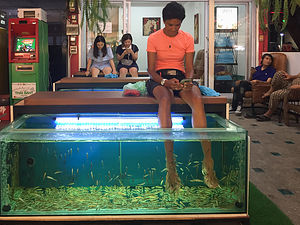 Fish spa anyone?The night bazaar was quite a scene, not your typical night at the mall in New Jersey.
Fish spa anyone?The night bazaar was quite a scene, not your typical night at the mall in New Jersey.
First difference - ladyboys. As we wandered through the bazaar we noticed a couple of very beautiful flamboyantly dressed ladies - complete with low cut gowns, feathers, super high heels, the works. At first we thought they were prostitutes, but then realized they were ladyboys, or katoeys (meaning third gender) as they are called in Thailand. Ladyboys are well integrated into Thailand society and widely accepted amongst the people. They were gorgeous. We took a picture of one as she approached us, but she stopped us from taking any more without paying for the privilege first.
The second difference from NJ malls - fish spas. That’s right. People actually pay 300 Baht (about $10) to place their feet in a giant fish tank so that toothless garra rufa fish can nibble the dead skin tissue off their feet. Yuck! Udom actually warned us against doing this because one of his previous clients wound up in the hospital with an infection from an unhygienic tank.
From long neck women to ladyboys - another interesting day had come to a close. Tomorrow, elephants!!
Day 2 - Elephant Kingdom and more free time
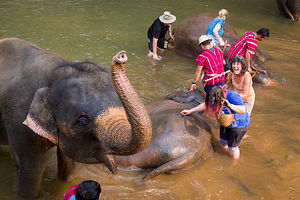 Lolo bathing the elephantsAnother day, another ethical challenge as a tourist, and rationalizing that the elephants truly are better off because of tourism.
Lolo bathing the elephantsAnother day, another ethical challenge as a tourist, and rationalizing that the elephants truly are better off because of tourism.
As commercial logging is slowing being outlawed in Southeast Asia, many elephants are being forced into early retirement. Without the income from logging, their owners can’t afford to keep or support them, so they have to go somewhere else or they will die. There just isn’t enough acreage in the wild to support the Thailand elephant population.
There are really only two options for them: an elephant sanctuary or an elephant camp. The difference is that a sanctuary is a true “retirement community” for the elephants, while in a camp, elephants are still well cared for, but they continue to be trained to entertain tourists.
Today, we would be visiting the Elephant Kingdom, where we would get to bathe, feed, and ride an elephant - in other words, an elephant camp. Udom assured us that these elephants were treated very well here and would die without places like this to feed and care for them. It reminded me a bit of the dilemma the long neck people were in. What about creatures that weren’t exotic or entertaining enough to earn a living through tourism. I guess their fate was much worse.
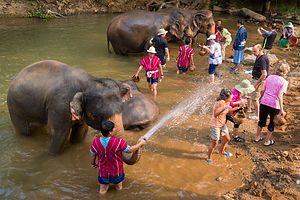 Washer or washee?Gate1 is such a big force in Thailand, that the Elephant Kingdom has a separate area devoted just to Gate1 tours, with 3 mahouts (trainers) and 4 elephants (one of them a rambunctious toddler).
Washer or washee?Gate1 is such a big force in Thailand, that the Elephant Kingdom has a separate area devoted just to Gate1 tours, with 3 mahouts (trainers) and 4 elephants (one of them a rambunctious toddler).
Our first interaction with the elephants was giving them a bath in the river. It was kind of like a car wash, but one where the cars squirted back. It was a bit scary at first, as they are very large animals, but their trainers were in the water with us, making sure no mishaps or tourist stomping occurred, which would be very bad for business.
As with all the Thai people we have met so far, the mahouts were always smiling, possibly because they were getting a chance to use the elephants’ trunks to squirt water on squealing tourists.
Now, that we had cleaned them, it was time to make them lunch. At this point, I was starting to feel a lot less guilty about the elephants’ life in the camp.
 Herb atop his pachydermThe mahouts gave us tamarind, salt, and cooked rice and, which we mixed, pounded, and rolled into balls. When the balls were complete, we set off to feed them. You had to be quick, because once the elephant got sight of that ball, if you didn’t offer it up, he was coming for it anyway. That certainly didn’t take long.
Herb atop his pachydermThe mahouts gave us tamarind, salt, and cooked rice and, which we mixed, pounded, and rolled into balls. When the balls were complete, we set off to feed them. You had to be quick, because once the elephant got sight of that ball, if you didn’t offer it up, he was coming for it anyway. That certainly didn’t take long.
It was now time to ride them - the moment I had been anticipating with excitement as well as a healthy dose of fear - these animals were huge!
We got a quick lesson as to how to mount them. Hold onto their ear with one hand, step up on the leg which they have bent for you, grab their skin with the other hand (trying not to pull their hair - yes, they have little hairs covering their skin), and pull yourself up - easier said than done. Then, you’re supposed to place your hands on the knobby bumps on their skull.
I waited and let others try first, including Herb. He did a really good job, forfeiting just a little bit of dignity along the way, before finally majestically (haha) mounting his pachyderm. I tried not to laugh, because I had no idea how my process would go. My attempt wasn’t too bad, but I did receive a little boost from behind by one of the helpers.
The ride was a bit rockier and more precarious than I expected, and I felt quite insecure holding onto nothing but its bumpy knobs as it rocked and swayed along. I kept trying to avoid the temptation of grabbing on to its hair, as I didn’t want to make him angry. We tried to look dignified and in control as our photos were taken.
 Lolo mounting her pachydermDismounting was a bit easier than getting on. All we really had to do was clutch an ear and slide down its side.
Lolo mounting her pachydermDismounting was a bit easier than getting on. All we really had to do was clutch an ear and slide down its side.
I do have to admit that we had a lot of laughs watching each others attempts at mounting and dismounting these really large animals. Everyone was such a good sport. I especially give credit to Henri, who was 81 years old. He gave up on the first attempt, but went back for a second and with a little extra help, made it. It was really quite inspirational.
After everyone had gotten a chance to ride, the mahouts brought the elephants forward so that we could pose with them. As we each took a turn standing between two of the larger ones, they poked us with their trunks and even gave wet kisses on our cheeks. It was pretty disgusting. I couldn't wait to wash my face.
The last event of the day, and the one that I found the tackiest, was the mahouts lining up the elephants so that we could offer them tips (dollar bills or bahts) as they reached out and grabbed them with their trunks. They just wouldn’t stop and I felt bad for one woman on our tour that kept being harassed by one until she practically handed over her entire pocketbook.
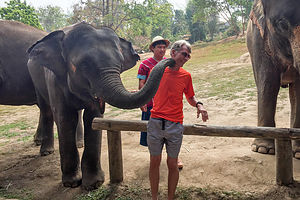 Herb getting a smoochAs we were leaving, there was a table with the photographs of each of us riding our elephant, set in a frame made from elephant dung - I am serious. Elephant dung is used to make paper products in Thailand. Kind of ironic that toilet paper is also made from dung. Of course, we just had to purchase it. I think it cost something like the equivalent of $10.
Herb getting a smoochAs we were leaving, there was a table with the photographs of each of us riding our elephant, set in a frame made from elephant dung - I am serious. Elephant dung is used to make paper products in Thailand. Kind of ironic that toilet paper is also made from dung. Of course, we just had to purchase it. I think it cost something like the equivalent of $10.
Herb and I are not big shoppers, so we skipped the afternoon excursion to Sankampang Street to see demonstrations on how silk, lacquer, silver, wood and bronze handicrafts are made. It was 95 degrees and humid, so instead we got a 2-pack of Chang beer at the 7-Eleven and hung out at the pool.
That evening we were on our own again for dinner, and not feeling terribly creative or adventurous, we went back to Lemongrass, had the same dinner as the night before, and then walked through the night bazaar. I think with all the new and changing stimuli, we needed some sense of routine.
Day 3 - Wat Suan Dok, Wat Phrathat Doi Suthep, visit to a local jade factory, authentic Thai dinner in a local Chiang Mai family’s home
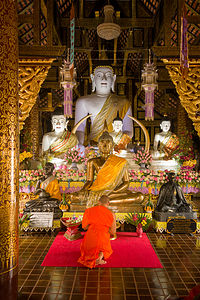 Wat Suan DokThis was it: the Gate1 finale - our last day of the tour. It was hard to believe it was almost over. It was even harder to believe how much we had seen and experienced in 11 days. It felt like we had been away from home for a month.
Wat Suan DokThis was it: the Gate1 finale - our last day of the tour. It was hard to believe it was almost over. It was even harder to believe how much we had seen and experienced in 11 days. It felt like we had been away from home for a month.
Our first stop of the day was the Wat Suan Dok, a 14th century temple of great significance, because it houses a very sacred Buddha relic - a bone believed to be from the shoulder of the Buddha. This sacred relic is enshrined in a large golden chedi (pagoda), surrounded by numerous white chedis that contain the ashes of several generations of the Chiang Mai royal family.
As legend has it, a monk named Sumana Thera from Sukhothai found the shoulder bone and brought it to King Kuene who ruled the Lanna Kingdom in the north (what is today Chiang Mai). When the monk arrived, the bone magically split in two. The smaller piece was enshrined in the Wat Suan Dok, but the king had the larger piece put on the back of a white elephant which was set free to wander wherever it wanted. The elephant chose to take the high road and wandered to the top of Doi Suthep mountain, where it was said to have trumpeted three times and then died.
 Ordination of young monks at Wat Suan DokTaking that a divine sign, the King had a Wat built on top of the mountain to house the relic, on the very spot where the elephant had collapsed. Later today we would be following in the footsteps of that elephant to visit the famous Wat Phra That Doi Suthep.
Ordination of young monks at Wat Suan DokTaking that a divine sign, the King had a Wat built on top of the mountain to house the relic, on the very spot where the elephant had collapsed. Later today we would be following in the footsteps of that elephant to visit the famous Wat Phra That Doi Suthep.
Before leaving the Wat Suan Dok thought, we did have the opportunity to watch an ordination ceremony for young monks in the ordination hall. Just like a graduation ceremony in the states, the hall was filled with proud parents and grandparents celebrating this important milestone in a young Thai boy’s life.
Then it was on to our very last temple on our Gate1 tour, the The Wat Phra That Doi Suthep, one of northern Thailand’s most sacred temples and a beautiful example of northern Thai architecture.
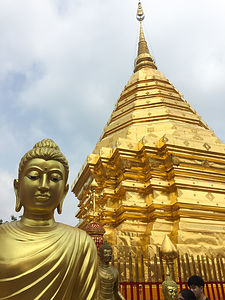 Wat Phrathat Doi SuthepFortunately, unlike the poor elephant that had to trudge up Doi Suthep with the Buddha’s shoulder bone strapped to his back, we got to ride up the steep hill in an air conditioned bus.
Wat Phrathat Doi SuthepFortunately, unlike the poor elephant that had to trudge up Doi Suthep with the Buddha’s shoulder bone strapped to his back, we got to ride up the steep hill in an air conditioned bus.
When reading about this temple beforehand, I was excited to see that there was a long 306-step staircase to reach the temple complex. Finally, some physical activity I thought - something greatly lacking on a guided tour. However, to my dismay, Udom herded us onto an elevator instead, which scooted us effortlessly to the temple complex on top.
From the outer terrace which was dotted with shrines and monuments, including one of the white elephant that carried the Buddha relic, we passed a lizard-like guardian dragon and entered an inner terrace and followed a walkway that circumnavigated a 79-foot tall golden chedi, within which was the Buddha’s shoulder bone.
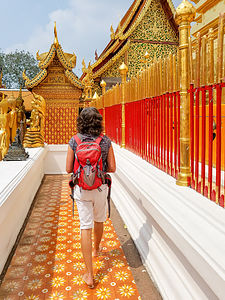 Inner Terrace of Wat Phrathat Doi SuthepIt was quite crowded with people stopping to leave lotus blossoms and other offerings at various shrines along the way. Each of the shrines had a Buddha statue with a particular pose and hand gesture. Each pose represents a day of the week, and you are supposed to pay respect to the statue representing the day you were born - something I learned on our brief visit into Myanmar, except that I later found out I making offerings to the Saturday Buddha when I should have been giving my lotus blossoms to the Thursday Buddha.
Inner Terrace of Wat Phrathat Doi SuthepIt was quite crowded with people stopping to leave lotus blossoms and other offerings at various shrines along the way. Each of the shrines had a Buddha statue with a particular pose and hand gesture. Each pose represents a day of the week, and you are supposed to pay respect to the statue representing the day you were born - something I learned on our brief visit into Myanmar, except that I later found out I making offerings to the Saturday Buddha when I should have been giving my lotus blossoms to the Thursday Buddha.
Based on what we had learned about the Buddha, I’m not sure how much he really cared about my offerings. Herb and I couldn’t help questioning whether this is what he really wanted from his followers. He clearly stated that he did not want to be worshiped and that one should shun the accumulation of material things as a way of seeking happiness. Yet here we were surrounded with glittery gold statues and buildings and people leaving offerings and bowing down before his image, as if he were a god. We would have to ask Udom how the Thai people reconcile this seeming paradox.
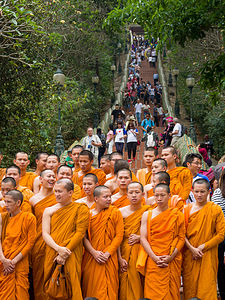 Monks about to earn Buddhist merits by climbing stairs to templeWe had some extra time, so I suggested to Herb that we go down the 306-step staircase, so that we could walk back up it like we should have in the first place. Ascending these steps is a way of gaining Buddhist merit. Herb thought it was kind of silly, but he knew better than to try to dissuade me on this.
Monks about to earn Buddhist merits by climbing stairs to templeWe had some extra time, so I suggested to Herb that we go down the 306-step staircase, so that we could walk back up it like we should have in the first place. Ascending these steps is a way of gaining Buddhist merit. Herb thought it was kind of silly, but he knew better than to try to dissuade me on this.
The balustrade of the staircase was a beautiful tiled mosaic water serpent (“naga”) that ran along its entire length. Besides representing a bridge between the earth and the sky, a naga is a sacred being believed to bring good luck.
So down we went, passing many monks on their way up, earning their merit points. Once at the bottom, we turned around and started back up again. I don’t think you get merit for just descending.
Along the way, there were little girls dressed in traditional Thai costumes. I stopped to take a photo of one really adorable one, who immediately held out her hand and said “money,” an English word that the children of Thailand have seemed to master.
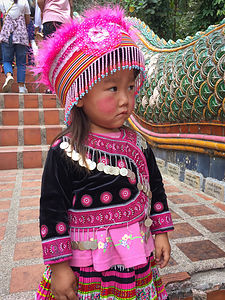 Another favorite little Thai girlOnce we had completed the folly of going down stairs, just so we could go up them, and then down them again, we met up with the rest of our tour group who had more sensibly taken the elevator down. They might have thought we were crazy, but we had earned Buddhist merit points and naga good luck.
Another favorite little Thai girlOnce we had completed the folly of going down stairs, just so we could go up them, and then down them again, we met up with the rest of our tour group who had more sensibly taken the elevator down. They might have thought we were crazy, but we had earned Buddhist merit points and naga good luck.
Once that Udom had us all gathered together again, we walked a short distance down the road to Orchid Jade, a jade factory where he had arranged for us to have a tour. From the moment we were offered fancy cookies and coffee, I knew this was not going to be a tacky gift shop. The jewelry and figurines were absolutely beautiful. My particular favorites were the carved elephants, but even the tiny ones were over $100. I looked at this stop as more of a museum visit than a shopping trip.
That evening, for our closing event, we gathered together at a local Chiang Mai family’s home to have an authentic Thai dinner. Herb and I wondered how they were going to accommodate such a large group, but when the bus pulled up in front of their beautiful teak home, we knew it would not be a problem.
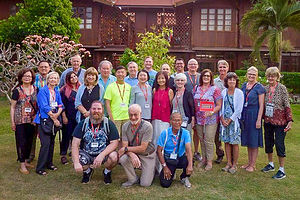 Our fellow travelers at our final dinner togetherOur hosts were lovely. They spoke English perfectly. The son, who was now in his late 20s had gone to high school in Los Angeles, so he very much knew all the idioms and expressions that a typical American teenager would. Many children of wealthy Thai families go to high school in the United States. They were quite affluent and well connected it seemed, as there were photos of them with the royal family.
Our fellow travelers at our final dinner togetherOur hosts were lovely. They spoke English perfectly. The son, who was now in his late 20s had gone to high school in Los Angeles, so he very much knew all the idioms and expressions that a typical American teenager would. Many children of wealthy Thai families go to high school in the United States. They were quite affluent and well connected it seemed, as there were photos of them with the royal family.
The food was delicious and the tour of their home afterwards was quite interesting. They even gave us some home-made curry paste to take home.
It was a lovely way to conclude our time together.
